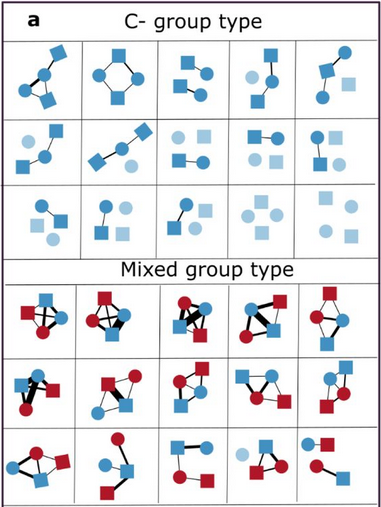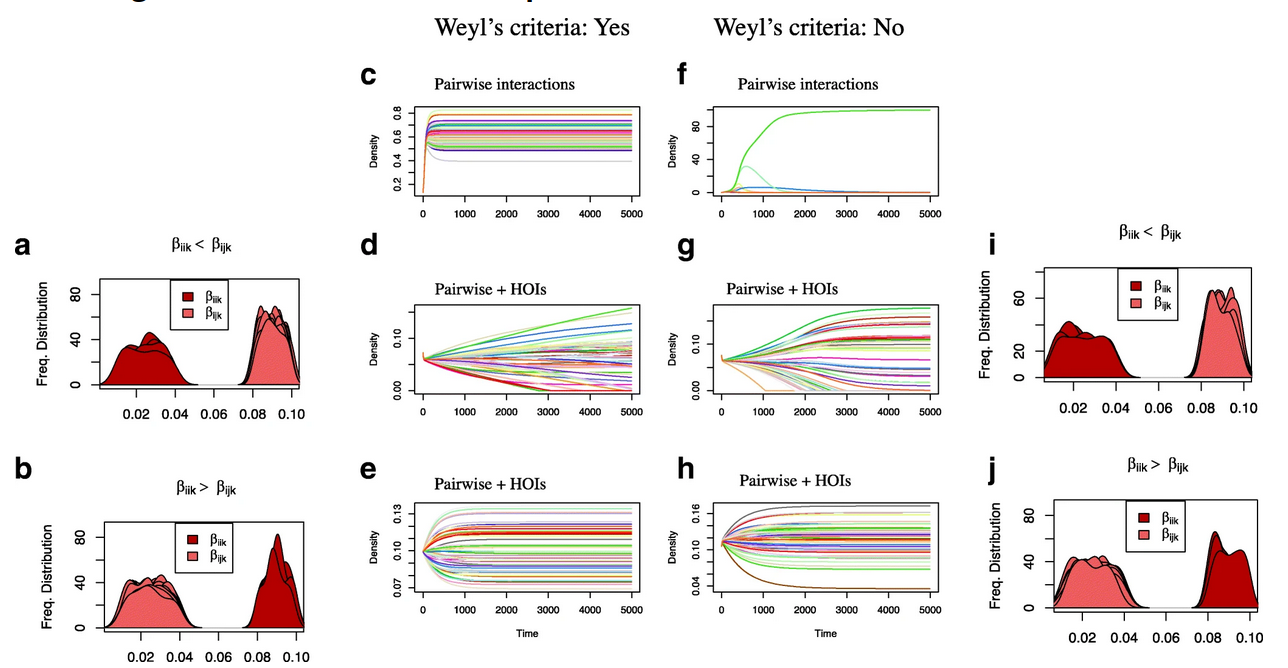2024

Plant metabolites modulate animal social networks and lifespan
Pragya Singh, Leon Brueggemann, Steven Janz, Yasmina Saidi, Gaurav Baruah, Caroline Müller
Journal of Animal Ecology (in press) 2024 New
Social interactions are prevalent in animals, with some individuals participating in more interactions than others. However, the mechanisms underlying this heterogeneity in social interaction frequency and its potential fitness consequences remain poorly characterized. Here, we examine the effects of non-nutritive plant metabolites ("clerodanoids") on social networks and lifespan in the turnip sawfly. ...


Predicting recoverability of collapsed food webs through perturbation and dimension reduction
Swastik Patnaik, Gaurav Baruah
bioRxiv 2024
Biodiversity collapse, driven by escalating environmental changes, poses significant threats to ecosystem stability and the provision of essential ecosystem services. Understanding the recoverability of collapsed food webs thus is crucial for devising effective conservation strategies. This study delves into the theoretical exploration of the recoverability of food webs from a collapsed state. Through simple tools like dimension reduction, propagation of species-specific perturbation, and dynamical simulations, we explore whether simple tri-trophic food webs can be recovered from a collapsed state. Our study examines in detail the topological features of predator-prey food webs that could either facilitate or impede their recovery....


Stability, resilience and eco-evolutionary feedbacks of mutualistic networks to rising temperature
Gaurav Baruah, Tim Lakaemper
Journal of Animal Ecology 2024 New
Ecological networks comprising of mutualistic interactions can suddenly transition to undesirable states, such as collapse, due to small changes in environmental conditions such as a rise in local environmental temperature. However, little is known about the capacity of such interaction networks to adapt to a rise in temperature and the occurrence of critical transitions....

2023

Transitions and its indicators in mutualistic meta-networks: effects of network topology, size of metacommunities and species dispersal
Gaurav Baruah
Evolutionary Ecology 2023
Gradual changes in the environment could cause dynamical ecological networks to suddenly shift from one state to an alternative state. When this happens ecosystem functions and services provided by ecological networks get disrupted. We, however, know very little about how the topology of such interaction networks can play a role in the transition of ecological networks when spatial interactions come into play. In the event of such unwanted transitions, little is known about how statistical metrics used to inform such impending transitions, measured at the species-level or at the community-level could relate to network architecture and the size of the metacommunity..


Reviving collapsed plant-pollinator networks from a single species
Gaurav Baruah, Meike Wittmann
PLOS Biology (in press) 2024
Mutualistic ecological networks can suddenly transition to undesirable states, due to small changes in environmental conditions. Recovering from such a collapse can be difficult as reversing the original environmental conditions may be infeasible. Additionally, such networks can also exhibit hysteresis, implying that ecological networks may not recover. Here, using a dynamical eco-evolutionary framework, we try to resurrect mutualistic networks from an undesirable low-functional collapse state to a high-functioning state. ..

2022
Evolutionary effects of individual variation and dimensionality of higher-order interactions on robustness of species coexistence
Gaurav Baruah, György Barabás, Robert John
bioRxiv 2022
lthough the eco-evolutionary effects of individual variation for species coexistence are still widely debated, theoretical evidence appears to support a negative impact on coexistence. Mechanistic models of eco-evolutionary effects of individual variation focus largely on pairwise interactions, while the dynamics of communities where both pairwise and higher-order interactions (HOIs) are pervasive are not known. In addition, most studies have focused on effects of high dimensional HOIs on species coexistence when in reality such HOIs could be highly structured and low-dimensional, as species interactions could primarily be mediated through phenotypic traits. ..


The impact of individual variation on abrupt collapses in mutualistic networks
Gaurav Baruah
Ecology Letters 2022
Individual variation is central to species involved in complex interactions with others in an ecological system. Such ecological systems could exhibit tipping points in response to changes in the environment, consequently leading to abrupt transitions to alternative, often less desirable states. However, little is known about how individual trait variation could influence the timing and occurrence of abrupt transitions. Using 101 empirical mutualistic networks, I model the eco-evolutionary dynamics of such networks in response to gradual changes in strength of co-evolutionary interactions...

2021
Effect of habitat quality and phenotypic variation on abundance- and trait-based early warning signals of population collapses
Gaurav Baruah, Christopher F Clements, Arpat Ozgul
OIKOS 2021
Loss of resilience in population numbers in response to environmental perturbations may be predicted with statistical metrics called early warning signals (EWS) that are derived from abundance time series. These signals, however, have been shown to have limited success, leading to the development of trait-based EWS that are based on information collected from phenotypic traits such as body size. Experimental work assessing the efficacy of EWS under varying ecological and environmental factors are rare. In addition, disentangling how such warning signals are affected under varying ecological and environmental factors is key to their application in biological conservation. Here, we experimentally test how different rates of environmental forcing (i.e. warming) and varying ecological factors (i.e. habitat quality and phenotypic diversity) affected population stability and predictive power of early warning signals of population collapse. ...

2020

Higher order interactions and species coexistence
Pragya Singh, Gaurav Baruah
Theoretical Ecology 2020
Higher order interactions (HOIs) have been suggested to stabilize diverse ecological communities. However, their role in maintaining species coexistence from the perspective of modern coexistence theory is not known. Here, using generalized Lotka-Volterra model, we derive a general rule for species coexistence modulated by HOIs. We show that where pairwise species interactions fail to promote species coexistence in regions of extreme fitness differences, negative HOIs that intensify pairwise competition, however, can promote coexistence provided that HOIs strengthen intraspecific competition more than interspecific competition...

Effect of time series length and resolution on abundance- and trait-based early warning signals of population declines
Alex Arkilanian, Christopher F Clements, Arpat Ozgul, Gaurav Baruah
Ecology 2020
Natural populations are increasingly threatened with collapse at the hands of anthropogenic effects. Predicting population collapse with the help of generic early warning signals (EWS) may provide a prospective tool for identifying species or populations at highest risk. However, pattern-to-process methods such as EWS have a multitude of challenges to overcome to be useful, including the low signal-to-noise ratio of ecological systems and the need for high quality time series data. The inclusion of trait dynamics with EWS has been proposed as a more robust tool to predict population collapse. ...

2019
Eco-evolutionary processes underlying early warning signals of population declines
Gaurav Baruah, Christopher F Clements, Arpat Ozgul
Journal of Animal Ecology 2019
Higher order interactions (HOIs) have been suggested to stabilize diverse ecological communities. However, their role in maintaining species coexistence from the perspective of modern coexistence theory is not known. Here, using generalized Lotka-Volterra model, we derive a general rule for species coexistence modulated by HOIs. We show that where pairwise species interactions fail to promote species coexistence in regions of extreme fitness differences, negative HOIs that intensify pairwise competition, however, can promote coexistence provided that HOIs strengthen intraspecific competition more than interspecific competition...

When Do Shifts in Trait Dynamics Precede Population Declines?
Gaurav Baruah, Christopher F Clements, Arpat Ozgul
The American Naturalist 2019
Predicting population responses to environmental change is an ongoing challenge in ecology. Studies investigating the links between fitness-related phenotypic traits and demography have shown that trait dynamic responses to environmental change can sometimes precede population dynamic responses and thus can be used as an early warning signal. However, it is still unknown under which ecological and evolutionary circumstances shifts in fitness-related traits can precede population responses to environmental perturbation....

2018
Tundra Trait Team: A database of plant traits spanning the tundra biome
Anne D Bjorkmann, Isla H. Myers-Smith,, Sarah C. Elmendorf, ......, Gaurav Baruah, .....
Global Ecology and Biogeography 2018
The Tundra Trait Team (TTT) database includes field-based measurements of key traits related to plant form and function at multiple sites across the tundra biome. This dataset can be used to address theoretical questions about plant strategy and trade-offs, trait–environment relationships and environmental filtering, and trait variation across spatial scales, to validate satellite data, and to inform Earth system model parameters....

Impacts of seven years of experimental warming and nutrient addition on neighbourhood species interactions and community structure in two contrasting alpine plant communities
Gaurav Baruah, Ulf Molau, Annika K Jagerbrand, Juha M Alatalo
Ecological Complexity 2018
Global change is predicted to have major impacts on alpine and arctic ecosystems. Plant fitness and growth will be determined by how plants interact with each other at smaller scales. Local-scale neighbourhood interactions may be altered by environmental pertubations, which could fundamentally affect community structure. This study examined the effects of seven years of experimental warming and nutrient addition on overall changes in the community structure and patterns of interspecific interaction between neighbouring plant species in two contrasting alpine plant communities, mesic meadow and poor heath, in subarctic Sweden...

2017
Community and species-specific responses of plant traits to 23 years of experimental warming across subarctic tundra plant communities
Gaurav Baruah, Ulf Molau, Yang Bai, Juha M Alatalo
Scientific Reports 2017
To improve understanding of how global warming may affect competitive interactions among plants, information on the responses of plant functional traits across species to long-term warming is needed. Here we report the effect of 23 years of experimental warming on plant traits across four different alpine subarctic plant communities: tussock tundra, Dryas heath, dry heath and wet meadow. Open-top chambers (OTCs) were used to passively warm the vegetation by 1.5–3 °C. Changes in leaf width, leaf length and plant height of 22 vascular plant species were measured...

